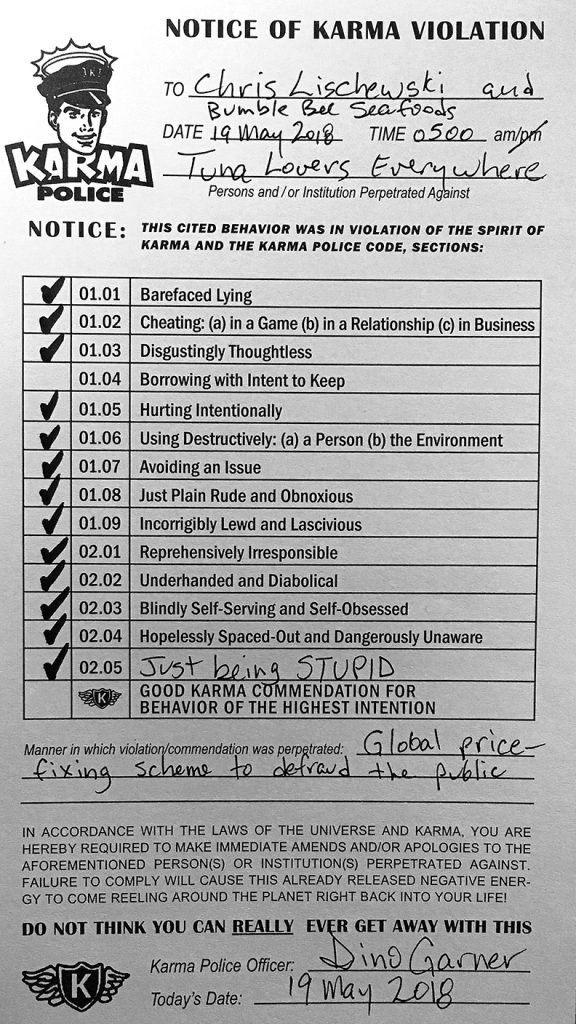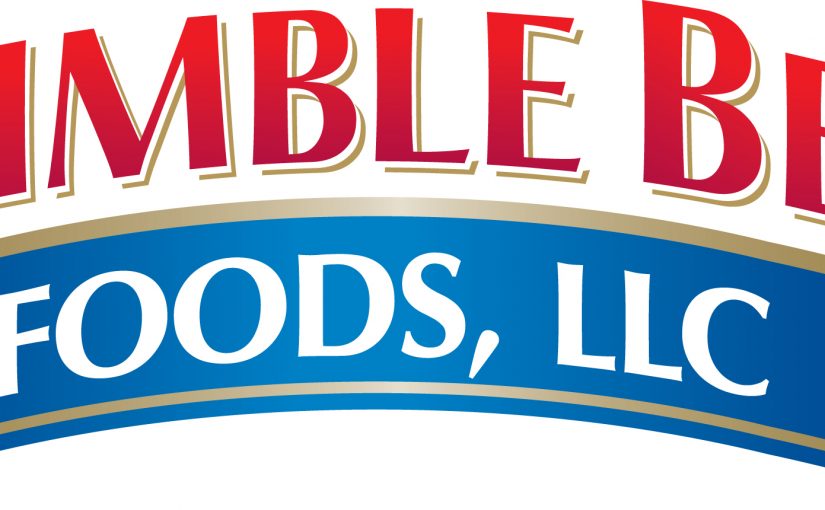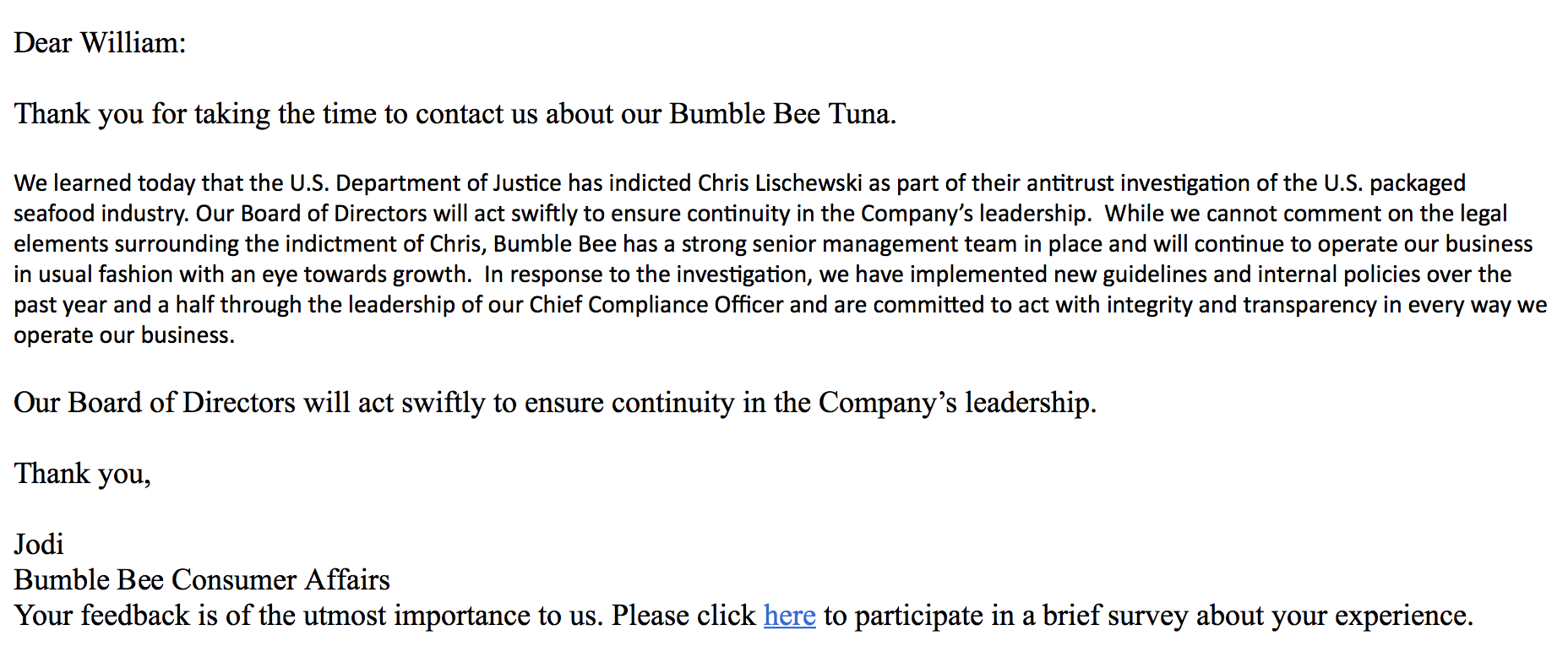My Pops loves tuna. Guess he needs his minimum daily requirement of mercury, lead, arsenic, cadmium, and various delicious toxins (pesticides, flame retardants and PCBs, just to name a few).
Marine scientists tell us that tuna is “safer” to eat than most other fish because they’re always on the move and swim so fast (the tuna, not the scientists). I wonder if these same marine scientists are aware of global ocean pollution, including nanoplastics and their breakdown products, and that tuna are a global oceanic predator that consumes smaller fish that have concentrated these deadly metals and toxins in their systems, and pass them onto tuna. Yup, I wonder.
Pops and the Giant Tuna Parade
Pops recalled to me this cool story about diving off Catalina Island (26 miles west of LA) in 1985 or thereabouts, when he sat right at the edge of a deep drop-off that extended down 3,000 feet. It was a fave spot of deep-ocean predators that congregated and swam in massive schools … back when there were massive schools of beautiful fish in the sea.
The visibility that day Pops was diving was excellent so he could see out about 200 feet. He just sat there, mesmerized by the shimmering layers of blue hues … when suddenly a fleet of dark-blue VW vans pulled into the picture: a massive school of giant bluefin tuna, each one easily 10 feet long and weighing more than half a ton.
“A wonder of the world,” he told me years later. “Seeing one giant tuna woulda sent little shocks throughout my body, but seeing hundreds of them at once—wow! Getting hit by lightning, the kind that welds you to the ground so you have no choice but to witness the power of Mother Nature.”
Pops said the school parade lasted for five minutes. Since he’s an old man with sagging skin and memory, one not immune to telling a big fish story, I’ll cut it down to three minutes.
Some fun modeling and 3rd-grade math:
The parade of blues was about 100 feet high and 100 feet wide, according to Pops who’s a very keen observer, with spacing among the fish at about 10 feet. The number of rows of fish from top to bottom of the school woulda been about 10. The number of columns about 10, and probably more since they were flying in a staggered formation, which woulda squeezed in about 25% more fish. However, since I’m being conservative, I’ll conveniently ignore the extra 25%.
Pops estimated they were running at about 7 miles an hour (10 feet/sec) for about 180 seconds (Pops said five minutes and I edited his big-fish estimate down to three). Every minute, approximately 3,000 blues passed Pops. In three minutes, 9,000. And that’s probably a little liberal, as some “experts” would rightly argue, since the school is not a perfect rectangular prism or cylinder. Could even be a hexagonal prism. Let’s just invoke Occam’s razor and model it with simplicity in mind: a half-mile-long rectangular prism.
9,000 big, beautiful giant bluefin tuna. And Pops witnessed the whole parade, as they cruised the length of the cooler waters of southern California.
We will never have such a spectacle again in our lives, thanks to overfishing and direct and run-off pollution of our waters and creatures on the low rungs of the food chain.
Raised on Tuna and Rock N Rock
Pops practically raised me on seafood. Growing up in Santa Barbara, California allowed us to have fresh shark, tuna, lobster, crab and other delish foodstuffs for many years.
Oh, and rock n roll.
Around my 10th birthday, though, I started noticing that canned albacore tuna wasn’t so chunky anymore. Just clumps of the occasional “solid” tuna. That’s when environmental groups sounded the alarm about the imminent crash of the tuna (and entire) fishing industry. Methinks they didn’t sound the klaxon on my behalf; pro’ly saw it for themselves.
The Three Blind Mice Design a Conspiracy
Fast-forward more than 13 years later: the Big Three of the tuna industry saw the writing on the wall and decided to conspire to fix prices of tuna around the world, especially here in the US where consumption of canned tuna is more than 50% of the world’s supply. Most of the tuna we consume is reported to be skipjack and albacore, with bluefin tuna being used by the Japanese in their massive sashimi and sushi industry.
Bluefin tuna can thank McD’s, Wendy’s and Burger King for flooding the Japanese market with fast food, a new distraction for the Japanese, not to mention the coming medical disaster (think: obesity, diabetes, cancer).
Bumbling Bees and Deep Doo-Doo
Bumble Bee is the second-largest brand of tuna in the world, with approximately 25% of the market share. The company does not own the fishing vessels that longline for their tuna, but former president and CEO, Chris Lischewski, has had a minority stake in the vessels managed by South Pacific Tuna Corporation. With his recent federal indictment on conspiracy charges, though, Chris will doubtless be dumping much of his stock to pay his attorneys in San Francisco so he can avoid prison time up at Pelican Bay.
Bumble Bee prides itself in being a socially responsible company, committed to purchasing only sustainable tuna and other fish. From their website:
“Bumble Bee Seafoods corporate social responsibility program also reaches beyond fisheries and across all aspects of our business, encompassing operations, packaging, supply chain, consumers, communities, and employees.”
[One teeny, little, insignificant detail: they forgot the apostrophe after the s in Seafoods and the hyphen between social and responsibility. No biggee, but I expect more from a corporate-communications copywriter.]
Stating it on a website does not mean they practice it, though.
Rutroh, Greenpeace. Yes, Again
According to Greenpeace, some of Bumble Bee’s supply-chain fishing vessels have been charged with illegal fishing and shark finning, and setting their nets on whales, the latter of which violated the Marine Mammal Protection Act. South Pacific Tuna Corporation settled out of court.
Greenpeace’s John Hocevar states: “Bumble Bee has failed to take the long-term viability of its business into account. It continues to exploit a resource that is currently ‘near threatened’ due to inadequate regulation and enforcement to manage the stocks, and has questionable social standards for the supply of its main product. These contribute to significant environmental, social and governance risks in its supply chain.”
When the Bough Breaks, Tuna Man Will Fall
When I read more and more about Chris Lischewski and Bumble Bee, I discussed it with my Pops who never reads mainstream news, so he wasn’t aware of Lischewski’s indictment.
This is where the whole Bumble Bee tuna story got fascinating.
Pops looked him up and, sure enough, it was the same Chris Lischewski he was friends with in grade school, Bitburg Elementary in Bitburg, Germany. Soon as Pops confirmed it, he fired off a letter to Lischewski at Bumble Bee:
Dear Chris,
I recall you from our days in Miss Tinti’s English class and many others we shared together at Bitburg Elementary School in Germany, in the late ’60s-early ’70s: you were bright, thinking and diligent.
Later, we attended University of Southern California where you had clearly “turned.”
What happened to you?
As a boy, you had a short bowl cut that was always trimmed, your clothes were always stylish, clean and pressed, your shirt buttoned up to the top, your senses always keen to listen and see and feel. Your questions about passages in books we read were thoughtful.
I remember you well because I admired you and how you carried yourself.
Those days have long since passed, my old friend. You have stolen money from my own pocket with your silly price-fixing schemes over the years.
Shame on you.
Never again will my family buy your or anyone else’s tuna. ‘Sides, the last time I saw schools of giant bluefin or albacore in the open ocean was in 1985. You guys have all but depleted one of Mother Nature’s precious resources, you greedy bastard.
I have a four-line response to you and your actions:
1. Fuck that.
2. Fuck you.
3. Fuck yours.
4. Fuck off.
Cheers,
Dino
A day later, Bumble Bee’s Consumer Affairs (ConsAffairs@bumblebee.com) responded to Pops’ letter to Lischewski (Ref. #000783348A):
Pops’ response? Check it:

Pops kinda says it all with that one, so I’ll wish you all a grand day and fade off into the western sky. Thank you for taking the time to read my little big-fish story.
MEET YOUR AUTHOR
Tripsy South is the author of the novel WTF, Dorkus! Schoolin’ My Shrink On Teen Suicide. Trained in physics at a cool surfer university, she lives and plays in Los Angeles where she’s a freelance writer/editor and copywriter. Ring her here.




One thought on “Anatomy of Bumbling Bee Chris Lischewski: How Corporate Arrogance, Malfeasance, Miscalculation and Conspiracy Led to the Worldwide Tuna Tragedy”
Comments are closed.